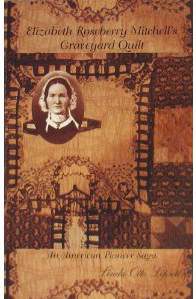Births, Marriages and Deaths
Last week, a friend shared wonderfully invigorating news, she is to be a grandmother next year. This in and of itself is not hard to believe, her daughter is in her late twenties, married, employed, all good, the natural order of things. Life is good. For me this baby has special noteworthiness, none of my other friends are at that stage. I am playing with the idea of making another baby quilt. Kim is the first friend I know of, to reach this milestone – grandmother on deck. I smile thinking of the joy her daughter has ahead. I hope she has a daughter so that joy will be compounded. I know this because I am lucky enough to be the mother of a daughter and yes, I have made her three quilts, two of them were birth quilts with squares pieced by her ancestors, relatives and cousins….
Elizabeth Roseberry Mitchell’s Graveyard Quilt
This is why genealogists are never finished, why it is so hard to stop and publish. Someone, bless them, always has another child, another descendant to be added to the family story, chart or tree. It is exactly why no genealogical project is ever done. Life continues and must be chronicled. Family history goes on and on, forward and backward.
I reread Elizabeth Roseberry Mitchell’s Graveyard Quilt: An American Pioneer Saga by Linda Otto Lipsett. This book was published in 1995 by Halstead & Meadows Publishing of Dayton, Ohio. If they no longer have copies, it can probably be purchased from Amazon, ABE Books or Alibris in addition to local bookstores and used bookstores.
Since I enjoy reading, quilting and researching, this book combining all three in one package was a natural present. Both the practice quilt top and the quilt itself are in museums in Kentucky, a state I hold dear to my heart, where I have done much research and have tons of relatives. The quilt top is housed in the Highlands Museum & Discovery Center in Ashland, Kentucky, while the quilt itself is in the Kentucky Historical Society‘s collection in Frankfort.
This book contains some of my favorite subjects, family stories, genealogy, research, quilts and migration. The time frame, the 1800s, was when farm families of eight to twelve children were the norm, and when internal migration, generally east to west, in this case from Pennsylvania, to Ohio, Kentucky, Wisconsin, Illinois, Kansas and then on to California, was a typical American migration story. Lipsett follows each of Elizabeth’s children from birth to death including spouses and children along the way. She also supplies corrected dates from contemporaneous sources for some of the incorrectly embroidered dates on the quilt. Another reason, it is so hard to finish and publish, mistakes.
Many quilts are made or given in honor of a marriage or birth. Friendship quilts were made specifically for migrating friends. I was given a quilt made by my great grandmother and her mother, my great great grandmother, as a wedding present from my mother. I have quilted six baby quilts as birth presents. The quilt in this book centered on the last of the three, births, marriages and deaths, and in that way it was unique.

Elizabeth Roseberry Mitchell and Shadrach Mitchell were the parents of eleven children whose births spanned 23 years; Roseberry Mitchell, Thomas Hughes Mitchell, Sarah Mitchell Stallcup McElroy, Mathias Mitchell, Hiriam Heaton Mitchell, Benjamin Franklin Mitchell, Elizabeth Mitchell Boyd, John Vannatta Mitchell, David Sellers Mitchell, Shadrach Lindsey Mitchell and Bazzle Morris Marling Mitchell. Two of those sons predeceased their parents. She started the quilt with them in mind and added family members staging their coffins outside in the border with their names and birth years pinned on each coffin. All this surrounding patchwork stars and a center medallion, a graveyard with coffins for her two sons stitched in. Two hundred years later it seems a little morbid, but at the time, it’s hard to say. What began as a way to assuage her grief definitely changed into creating a family heirloom. Otherwise after creating the first quilt top, she would have stopped instead of making a slightly different and, in her mind’s eye, better quilt top and then quilting it. It was another way, in addition to a family bible, to keep track of a geographically ever-widening group of children, siblings and first cousins, who might not keep in touch and would certainly never be buried together. It is comparable to memorial graveyards in FindAGrave that consist of the submitter’s family connected in one spot on the Internet though buried in separate cemeteries throughout multiple states. It is a family historian’s dream, a genealogist’s treasure.
Thinking of all those stitches, perhaps I might quilt a small shoulder blanket instead of an entire crib quilt. It’s so hard to take time away from researching.









